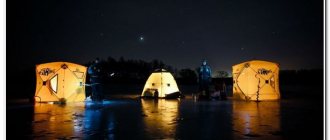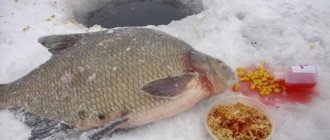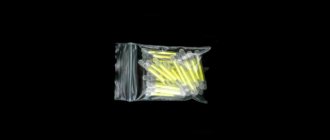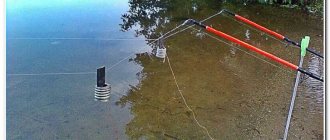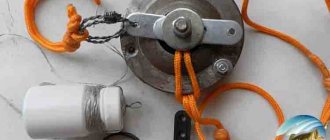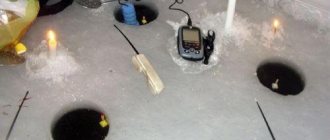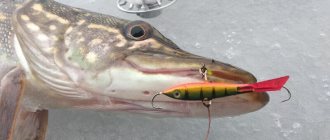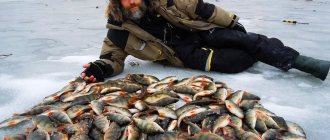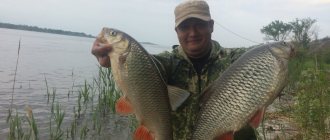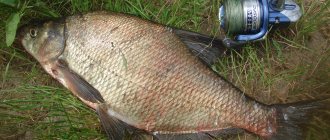Do bream bite at night?
Night fishing for bream is perhaps the most productive - it is at this time of day that you can get the maximum catch. The optimal period when there is a mass emergence of bream to feed falls on the time interval from 00:00 to 03:00.
As for the time of year, these fish are most active in the summer months (July, August), when the water temperature varies between +20...+22°C (this period may shift slightly depending on the climatic and weather conditions of the region), and also during spawning - from March to May.
However, biting can also be observed in other seasons, for example, in autumn, especially in the first half and winter, but with the least probability, since the level of fish activity is almost zero.
The following parameters should also be taken into account:
- atmospheric pressure - should be between 740–745 mm Hg. Art.;
- weather - its changes should not be observed for at least a day;
- windiness - during strong winds the fish dives much deeper.
The main thing when fishing at night is to maintain complete silence - even minor sounds can scare off the bream, after which it will stop being caught and go to another place.
Tackle
Two feeders are best suited for fishing at night, one for the distant edge, the other for the coastal edge. There is no need to feed both points, since in this case the feeding table will be smeared; it is best to feed the far edge while waiting on the near edge for the bream that has decided to approach the shore. For long casts, a four-meter feeder equipped with a spinning reel weighing no more than 160 grams is suitable. Closer to the shore we use a feeder about three and a half meters long with a reel weighing up to 100 grams.
Read: Bream. What he doesn't like
It is best to use braided line, but it is worth remembering that it does not stretch, which is a disadvantage when the fish jerks strongly and is fished out. In this case, a well-adjusted reel clutch and about 7 centimeters of feeder will help, which will save you in these situations.
Selecting a location and searching for fish
Due to its wide distribution, bream can be found in almost every fresh body of water. The only exception, perhaps, are small rocky rivers with very fast currents.
Finding habitats is quite simple - this fish prefers quiet, calm areas without strong currents and with a large amount of food (algae, crustaceans, larvae). In the summer, they usually go deeper, thus escaping the heat.

You can find bream in:
- creeks;
- reeds;
- deep pool;
- snag;
- bay or small bay.
Important! You should choose the most suitable place in advance, during daylight hours.
Necessary gear for night fishing for bream
Today, fishermen have a huge number of different options for fishing gear available to them. However, feeder fishing is the most popular; it is this method that is most often preferred over others by both professionals and amateurs.
In order to guarantee a good bite, you should prepare your gear in advance:
- The first step is to determine the length of the feeder - depending on the expected casting distance, it can range from 300 to 360 cm.
- A reel is chosen with a spool capacity of 4000–5000 and a baitrunner, which allows a fisherman who is not constantly near the rod at night to realize a bite.
- The weight of the feeder in the absence of flow can be no more than 70–80 g, otherwise - no less than 100 g. It is best to choose a shape with corners, which will prevent it from being pulled along the bottom, or an elliptical shape.
- The main line must be monofilament and strong, at least 0.2 mm in diameter. Instead, you can also use a braided cord with a thickness of about 0.16 mm.
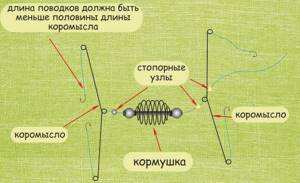
Another popular fishing method is fishing with a float rod, which has several varieties:
- flywheel, with a rod length of 3–12 m - characterized by a fairly limited casting range, and therefore is used in small bodies of water with standing water or moderate currents;
- Bolognese, with a rod length from 4 to 8 m - equipped with a spinning reel and rings, which makes it possible to fish at some distance from the shore;
- match, with a rod length of about 6 m - in addition to the spinning reel, it is equipped with a fairly heavy float, which allows you to cast the equipment at a distance of 30 to 60 m from the shore;
- plug-in, with a rod up to 15 m long - the best option for any body of water, but it requires some handling skills, and therefore is usually used only by professional fishermen.
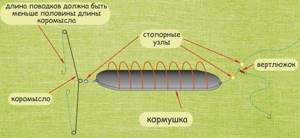
Bottom tackle for catching bream in strong currents.
When choosing match or plug tackle, you should pay attention to the reel - the best option is to have a friction brake on it, which will allow you to adjust the braking when fishing. The thickness of the monofilament is also important - at least 0.2–0.25 mm.
Also check out the most suitable gear for catching pink salmon.
Equipment also plays an important role:
- floats - the shape depends on the intensity of the current (for a fast current, a flat shape is the best option, for standing water - a spindle-shaped one), and the weight can vary between 1.5–5 g (depending on the wind strength);
- hook - selected based on the potential bait (for worms - No. 6–8, for bloodworms and maggots - No. 12–14).
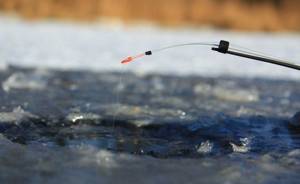
For winter fishing, a nodding or, as it is also called, jig fishing rod is often used.
Such gear consists of:
- whip, length - from 15 to 20 cm;
- working line, which is used as a monofilament with a thickness of 0.12 to 0.14 mm;
- jig - weight can vary depending on the depth (up to 4 m - 0.35 g, deeper - 1.87 g).
Important! For fishing at night, the float must be equipped with an illuminated antenna.
Selection and preparation of a site
To choose a good place, consider the following factors: the width of the reservoir and bottom features, landmarks on the opposite bank and the amount of vegetation in the fishing area.
If the river is wide, then there is no need to worry. And if the reservoir is up to 50 m, then there is a risk of throwing the bait to the other side and breaking the tackle. In this case, it is better to position yourself not perpendicular to the current, but at an angle of about 45-30 degrees to the water’s edge. Then the cast will be made to the middle of the river or closer to your bank.
If this is your first time on a pond, then first study the bottom well.
It is not recommended to catch bream with a feeder at night in pits. At dusk, fish come out of the holes to feed closer to the shore. A flat sandy or clay bottom with a shell, without mud and river algae, is an ideal option. The bait will not sink into the mud, and the fish will see it clearly. Usually this is the bottom on beaches.
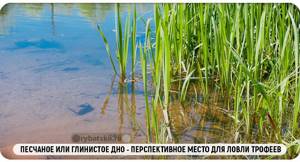
If you want to catch bream on a feeder in comfortable conditions and spend less time preparing the place, choose a sandy shore. The main advantage is that there is no grass under your feet, you don’t need to mow anything. There will be no snags when swinging the rod, the line will not break or get tangled.
It is better to arrive at the place at least an hour or an hour and a half before dusk. We need to settle in and make some bait. It is advisable to look around, check that nothing interferes with comfortable casting either in front or behind. If necessary, you can mow the grass and trim the bushes.
Check your flashlights. Attach the fireflies with tape or use a special tube before dark. You can aim, make several casts, calculate the force of the swing, and then throw in one place.
For more accurate casting, you need landmarks on the opposite bank, which can be seen in the dark. Those that were used during the day do not always help. Suitable: large trees, a hillock or a hill.
The moon is not an option because it is constantly moving.
You can also use a long landing net as a guide. While it’s still light, you need to record your marks when casting and place a catch on the stand so that its handle accurately points in the desired direction.
Groundbaits and bait
Catching bream is impossible without preliminary bait. When going fishing at night, you should feed the fish in advance, during the day or in the evening, since with the onset of darkness these aquatic inhabitants become extremely timid, and therefore any particles, even edible ones, falling into the water will be considered a danger from which you should swim away as quickly as possible further.

The composition of the feed mixture may vary slightly depending on fishing conditions (presence of current or standing water).
Despite this, the required components are:
- Cake is the main product, which can consist of flax, sunflower, pumpkin fibers or rapeseed. The main thing is that there is no mold on it.
- Breadcrumbs - their type (wheat/rye) should be selected based on the color of the soil. For example, light-colored crackers will stand out less on a sandy and clayey bottom, and dark ones on a muddy bottom.
- Bran - used to loosen the structure of the mixture, which is required when fishing in still water.
- Clay or flour - one of the presented ingredients can act as a binder for the bait (can be replaced with oatmeal or ground peas).
- Flavors are selected separately for each season. For example, in summer it is better to add a small amount of vanillin to the mixture, and in winter anise is preferable. It is also permissible to add coriander, cumin, dill (seeds) or artificial flavors in liquid form (banana, apricot, strawberry and other flavors).
Did you know? Being a freshwater fish, bream is not afraid of salt water, and therefore can often go out into the seas into which it enters through rivers (for example, individuals can often be found in the Black, Azov, Caspian or Baltic seas).
There are a large number of ways to make bait yourself:
- For fishing in summer, the working mixture is made from 200–250 g of breading, 200 g of ground fried sunflower seeds, 300 g of bran, 300 g of boiled millet, 2 tsp. ground coriander and clay (until the desired consistency is obtained).
- Spring feeding consists of 100 g of sunflower cake, 100 g of steamed millet, 100 g of bran (rye), 50 g of bloodworms, 2 tsp. ground coriander, a small amount of clay (can be replaced with sand).
- To prepare the autumn mixture you will need 150 g of light breadcrumbs, 150 g of sunflower cake, 70 g of unsalted lard, 150 g of bran (rye), 150 g of rice porridge, 40 g of bloodworms or maggots, 1-1.5 tsp. ground coriander and clay.
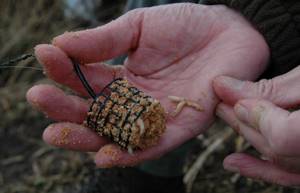
The next important step is preparing the bait, which may vary depending on the time of year.
So, in winter, the easiest way to catch bream is with bloodworms, worms, maggots or dough. In the spring, before spawning, the fish prefers dung worms, leeches, chafer larvae, and after spawning - worms, maggots, as well as butter dough or semolina. With the onset of autumn, you can use steamed peas, pearl barley, as well as worms, bloodworms or maggots as bait.
Find out what bait to choose for catching chub and how to make it yourself.
Parking arrangement
In order for night bream fishing in winter to be perceived as an interesting and enjoyable pastime, you will need to have the necessary equipment and preparation. Bream can start at the beginning of evening twilight, or maybe in the morning. A cold winter night in nature will seem much more comfortable if you approach the preparation with all responsibility.
Recommended reading: How to catch tench with a fishing rod
After finding a promising point, 3-4 holes are drilled so that they are convenient to use in the tent. It is better to install the tent with its back side facing the wind, which will give it additional stability in windy weather.
To heat the “home,” stoves using gas or fuel briquettes are used. In the absence of a stove, provided it is not very cold, you can put and light several paraffin candles.
Important. When using any sources of tent heating, care must be taken to ensure ventilation.
Fishing equipment
Depending on the time of year, weather conditions and existing skills, a night fishing fisherman may need additional equipment:
- headlamp - for outdoor fishing;
- tent - in the case of winter fishing or as a place to relax;
- a lamp for the tent, and in the cold season - a heater;
- ice ax - for forming holes in the ice.
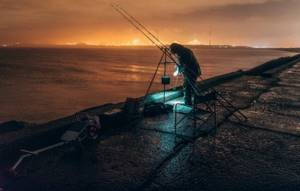
You should take care in advance about comfortable clothes and shoes, as well as food, which, at a minimum, should include a drink and a small snack (and in the cold season - hot tea or coffee in a thermos). Additionally, you will need night equipment - for example, float antennas equipped with fireflies, which are clearly visible in complete darkness, or bells as bite alarms.
Fishing tactics and fishing
The main thing in fishing is not the number of gear involved, but the correct choice of place and gear, as well as the use of experience and skills:
- You need to cast accurately and bring out the bream in quick jerks.
- If you are not confident in the strength of the fishing line, then you should let the fish spin circles at the bottom.
- Next, you should bring it to the surface and let it breathe air, and only then smoothly bring it to the shore.
It is worth noting that night fishing is a lottery, so you may not catch bream. But this does not mean that it will always be like this.
The river bank is the home of blood-sucking insects; it is recommended to take repellent with you, but it is worth considering that its pungent smell when it gets into the water can scare off fish, so avoid getting it on your hands.
Advantages and disadvantages of night fishing
Night fishing has many benefits. Some obvious ones include the lack of many other fishermen and the coolness in the summer. An additional advantage is the almost complete absence of small fish at this time of day (the possibility of catching large specimens explains why many “bream fish” go fishing only at night) and the bream going out into shallow water to hunt for food.
Low visibility in dark water significantly reduces the chance of fish being spooked by the shine of the line. There are also some disadvantages - the same low level of illumination makes it difficult to observe the bite, and some drowsiness makes movements slow.
Bait
When you go fishing for bream, you need to stock up on a large amount of bait; a bunch of worms is best for this. This bait is voluminous and clearly visible in the water; another advantage is that catfish can also take it, which will be a pleasant bonus.
Read: Catching bream in late summer
Another classic bait is considered to be maggot, and the best effect is achieved when creating a sandwich, when first a bunch of worms are placed on the hook, and then the maggot.
